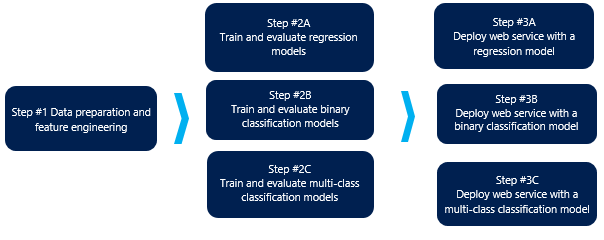New Predictive Maintenance Template in Azure ML
This blog post is authored by Yan Zhang, Data Scientist at Microsoft.
Following the publishing of three Azure ML template solutions for online Fraud Detection, Retail Forecasting, and Text Classification, we are now pleased to announce that the Predictive Maintenance template is now available in Azure ML.
Predictive maintenance encompasses a variety of areas but the broad goal is to increase the efficiency of maintenance related tasks. Data-driven predictive maintenance, in particular, is gaining increasing attention in the industry along with applications in the emerging realm of the Internet of Things (IoT).
This particular template focuses on answering the question of “When will an in-service machine fail?” and illustrates this process by predicting future failure events in the scenario of aircraft engines.
We re-formulate the question and propose three modeling solutions to accomplish the following tasks:
Regression: Predict the Remaining Useful Life (RUL), or Time to Failure (TTF).
Binary classification: Predict if an asset will fail within certain time frame (e.g. days).
Multi-class classification: Predict if an asset will fail in different time windows: E.g., fails in window [1, w0] days; fails in the window [w0+1,w1] days; not fail within w1 days (exchangeable with other time units in real scenarios).
The input data includes simulated aircraft engine run-to-failure events, mainly including sensor measurements for engines in each working cycle until failure. The regression models predict how much longer an aircraft engine will last before it fails. The classification models predict whether an engine is in non-failing or failing conditions based on the engine’s current operation conditions such as current working cycle, settings, sensor measurements and so forth.
This template consists of 3 steps and 7 experiments. These experiments include major data science steps from data input, data pre-processing, feature engineering, feature selection, model training and evaluation, to model deployment as a web service.
The experiment flow diagram is shown below:
Here are links to each step or experiment in the template:
Predictive Maintenance: Step 1 of 3, data preparation and feature engineering
Predictive Maintenance: Step 2A of 3, train and evaluate regression models
Predictive Maintenance: Step 2B of 3, train and evaluate binary classification models
Predictive Maintenance: Step 2C of 3, train and evaluation multi-class classification models
Predictive Maintenance: Step 3A of 3, deploy web service with a regression model
Predictive Maintenance: Step 3B of 3, deploy web service with a binary classification model
Predictive Maintenance: Step 3C of 3, deploy web service with a multi-class classification model
In addition, we also provide a complete development experiment to give user a holistic view of the template.
We hope you give this template a spin and are able to adapt it to your own predictive maintenance -related needs. We would love to hear your feedback and comments.
Yan
Comments
- Anonymous
May 26, 2015
This work is very useful for early faculty researchers like me. Thank you and please keep me posted of Azure ML updates in future at roych@uw.edu
